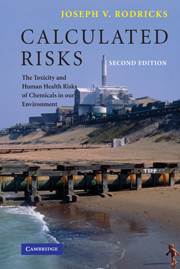Book contents
- Frontmatter
- Contents
- Preface to the first edition
- Preface to the second edition
- List of abbreviations
- Prologue
- 1 Chemicals and chemical exposures
- 2 From exposure to dose
- 3 From dose to toxic response
- 4 Toxic agents and their targets
- 5 Carcinogens
- 6 Identifying carcinogens
- 7 Risk assessment I: some concepts and principles
- 8 Risk assessment II: applications
- 9 Risk assessment III: new approaches, new problems
- 10 Risk assessment IV: the courtroom
- 11 The management of risk
- 12 A look ahead
- Sources and recommended reading
- Index
6 - Identifying carcinogens
Published online by Cambridge University Press: 25 August 2009
- Frontmatter
- Contents
- Preface to the first edition
- Preface to the second edition
- List of abbreviations
- Prologue
- 1 Chemicals and chemical exposures
- 2 From exposure to dose
- 3 From dose to toxic response
- 4 Toxic agents and their targets
- 5 Carcinogens
- 6 Identifying carcinogens
- 7 Risk assessment I: some concepts and principles
- 8 Risk assessment II: applications
- 9 Risk assessment III: new approaches, new problems
- 10 Risk assessment IV: the courtroom
- 11 The management of risk
- 12 A look ahead
- Sources and recommended reading
- Index
Summary
Beginning in the late 1940s, when Dr. Hueper established an Environmental Cancer Section at the NCI, and continuing to this day, a major program of carcinogen identification using animal tests has been conducted at the National Institutes of Health (NIH). At the present time most of this testing is conducted under the auspices of a government-wide activity called the National Toxicology Program (NTP) centered at another NIH unit, the National Institutes of Environmental Health Sciences (NIEHS) in Research Triangle Park, North Carolina. Several hundred chemicals have been tested for carcinogenicity by the NTP. The NTP and other federal health and regulatory agencies also sponsor epidemiology studies and other investigations into the underlying chemical and biological mechanisms by which some chemicals transform normal cells into malignant ones. In addition to government-supported work, there is substantial industry-sponsored testing and research of the same type, some of it performed because of regulatory requirements. The field of chemical carcinogenesis is a vast scientific enterprise, not only in the United States, but throughout the world.
One important part of this vast enterprise is the International Agency for Research on Cancer (IARC), a part of the World Health Organization, headquartered in Lyon, France. One of IARC's many activities involves convening meetings of scientific experts from across the world to examine published scientific work relating to the carcinogenicity of various chemicals. The IARC periodically publishes the results from the deliberations of these working groups.
- Type
- Chapter
- Information
- Calculated RisksThe Toxicity and Human Health Risks of Chemicals in our Environment, pp. 162 - 201Publisher: Cambridge University PressPrint publication year: 2006

